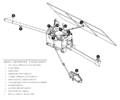Template:Selected anniversaries/September 25: Difference between revisions
No edit summary |
No edit summary |
||
| Line 3: | Line 3: | ||
File:Ole Rømer.jpg|link=Ole Rømer (nonfiction)|1644: Astronomer and instrument maker [[Ole Rømer (nonfiction)|Ole Rømer]] born. He will make the first quantitative measurements of the speed of light. | File:Ole Rømer.jpg|link=Ole Rømer (nonfiction)|1644: Astronomer and instrument maker [[Ole Rømer (nonfiction)|Ole Rømer]] born. He will make the first quantitative measurements of the speed of light. | ||
||1777 | ||1777: Johann Heinrich Lambert dies ... mathematician, physicist, and astronomer. | ||
File:Bill of Rights.jpg|link=United States Bill of Rights (nonfiction)|1789: The United States Congress passes twelve amendments to the United States Constitution: The Congressional Apportionment Amendment (which was never ratified), the Congressional Compensation Amendment, and the ten that are known as the [[United States Bill of Rights (nonfiction)|Bill of Rights]]. | File:Bill of Rights.jpg|link=United States Bill of Rights (nonfiction)|1789: The United States Congress passes twelve amendments to the United States Constitution: The Congressional Apportionment Amendment (which was never ratified), the Congressional Compensation Amendment, and the ten that are known as the [[United States Bill of Rights (nonfiction)|Bill of Rights]]. | ||
| Line 11: | Line 11: | ||
File:Judge Havelock With Glass.jpg|link=Judge Havelock With Glass|1845: ''[[Judge Havelock With Glass]]'' is "a reasonably accurate depiction of events as I experienced them," according to [[Judge Havelock|the Judge]]. | File:Judge Havelock With Glass.jpg|link=Judge Havelock With Glass|1845: ''[[Judge Havelock With Glass]]'' is "a reasonably accurate depiction of events as I experienced them," according to [[Judge Havelock|the Judge]]. | ||
||Christoph Gudermann | ||1852: Christoph Gudermann dies ... mathematician noted for introducing the Gudermannian function and the concept of uniform convergence. | ||
||Thomas Hunt Morgan | ||1866: Thomas Hunt Morgan born ... evolutionary biologist, geneticist, embryologist, and science author who won the Nobel Prize in Physiology or Medicine in 1933 for discoveries elucidating the role that the chromosome plays in heredity. Pic. | ||
||Stefan Mazurkiewicz | ||1888: Stefan Mazurkiewicz born ... mathematician who worked in mathematical analysis, topology, and probability. He will be known for the Hahn–Mazurkiewicz theorem, a basic result on curves prompted by the phenomenon of space-filling curves. Pic. | ||
File:Harald Cramér.jpg|link=Harald Cramér (nonfiction)|1893: Mathematician and statistician [[Harald Cramér (nonfiction)|Harald Cramér]] born. He will help found probability theory as a branch of mathematics, writing in 1926: "The probability concept should be introduced by a purely mathematical definition, from which its fundamental properties and the classical theorems are deduced by purely mathematical operations." | File:Harald Cramér.jpg|link=Harald Cramér (nonfiction)|1893: Mathematician and statistician [[Harald Cramér (nonfiction)|Harald Cramér]] born. He will help found probability theory as a branch of mathematics, writing in 1926: "The probability concept should be introduced by a purely mathematical definition, from which its fundamental properties and the classical theorems are deduced by purely mathematical operations." | ||
||Alexander Markowich Ostrowski | ||1893: Alexander Markowich Ostrowski born ... mathematician. | ||
||1906 | ||1906: In the presence of the king and before a great crowd, Leonardo Torres y Quevedo successfully demonstrates the invention of the Telekino in the port of Bilbao, guiding a boat from the shore, in what is considered the birth of the remote control. | ||
||1915 | ||1915: Ethel Rosenberg born ... American spy. | ||
|| | ||1922: Johannes Petrus Kuenen dies ... physicist. He discovered retrograde condensation and published his findings in 1892 in the Ph.D. thesis with the title "Metingen betreffende het oppervlak van Van der Waals voor mengsels van koolzuur en chloormethyl". (Measurements on the Van der Waals surface for mixtures of carbonic acid and methyl chloride). He performed early experiments with x-rays with the physiologist Edward Waymouth Reid. Pic. | ||
|| | ||1928: Richard F. Outcault dies ... cartoonist, created The Yellow Kid and Buster Brown. | ||
|| | ||1929: Jimmy Doolittle performs the first blind flight from Mitchel Field proving that full instrument flying from take off to landing is possible. | ||
|| | ||1933: Paul Ehrenfest born ... theoretical physicist, who made major contributions to the field of statistical mechanics and its relations with quantum mechanics, including the theory of phase transition and the Ehrenfest theorem. | ||
|| | ||1935: Adrien Douady born ... mathematician. | ||
|| | ||1955: Franz Rellich dies ... mathematician. He made important contributions in mathematical physics, in particular for the foundations of quantum mechanics and for the theory of partial differential equations. The Rellich–Kondrachov theorem is named after him. | ||
|| | ||1956: TAT-1, the first submarine transatlantic telephone cable system, is inaugurated. | ||
|| | ||1968: Hans F. K. Günther dies ... eugenicist and academic. | ||
|| | ||1969: Paul Hermann Scherrer dies ... physicist. | ||
||1986 | ||1975: Yehoshua Bar-Hillel dies ... philosopher, mathematician, and linguist. He is perhaps best known for his pioneering work in machine translation and formal linguistics. Pic. | ||
||1986: Nikolay Semyonov dies ... physicist and chemist, Nobel Prize laureate. | |||
File:Mars Observer diagram.png|link=Mars Observer (nonfiction)|1992: NASA launches the [[Mars Observer (nonfiction)|Mars Observer]], a $511 million probe to [[Mars (nonfiction)|Mars]], in the first U.S. mission to the planet in 17 years. The probe will fail eleven months later. | File:Mars Observer diagram.png|link=Mars Observer (nonfiction)|1992: NASA launches the [[Mars Observer (nonfiction)|Mars Observer]], a $511 million probe to [[Mars (nonfiction)|Mars]], in the first U.S. mission to the planet in 17 years. The probe will fail eleven months later. | ||
||Robert W (Bob) Floyd | ||2001: Robert W (Bob) Floyd dies ... computer scientist. His contributions include the design of the Floyd–Warshall algorithm (independently of Stephen Warshall), which efficiently finds all shortest paths in a graph, Floyd's cycle-finding algorithm for detecting cycles in a sequence, and his work on parsing. In one isolated paper he introduced the important concept of error diffusion for rendering images, also called Floyd–Steinberg dithering (though he distinguished dithering from diffusion). A significant achievement was pioneering the field of program verification using logical assertions with the 1967 paper Assigning Meanings to Programs. This was an important contribution to what later became Hoare logic. | ||
||Arnold Ephraim Ross | ||2002: Arnold Ephraim Ross dies ... a mathematician and educator who founded the Ross Mathematics Program, a number theory summer program for gifted high school students. Pic. | ||
File:Humpty Dumpty At Bat.jpg|link=Humpty Dumpty At Bat|2002: Steganographic analysis of ''[[Humpty Dumpty At Bat]]'' reveals previously unknown biography of Babe Ruth by [[Lewis Carroll (nonfiction)|Lewis Carroll]]. | File:Humpty Dumpty At Bat.jpg|link=Humpty Dumpty At Bat|2002: Steganographic analysis of ''[[Humpty Dumpty At Bat]]'' reveals previously unknown biography of Babe Ruth by [[Lewis Carroll (nonfiction)|Lewis Carroll]]. | ||
File:George Plimpton 1993.jpg|link=George Plimpton (nonfiction)|2003: Journalist, writer, literary editor, and actor [[George Plimpton (nonfiction)|George Plimpton]] dies. | File:George Plimpton 1993.jpg|link=George Plimpton (nonfiction)|2003: Journalist, writer, literary editor, and actor [[George Plimpton (nonfiction)|George Plimpton]] dies. | ||
File:Dennis_Paulson_of_Mars.jpg|link=Dennis Paulson of Mars|2017: ''[[Dennis Paulson of Mars]]'' says that the twenty-fifth anniversary of the launch of the [[Mars Observer (nonfiction)|Mars Observer]] is a bittersweet event, because the spacecraft will be lost eleven months later. | File:Dennis_Paulson_of_Mars.jpg|link=Dennis Paulson of Mars|2017: ''[[Dennis Paulson of Mars]]'' says that the twenty-fifth anniversary of the launch of the [[Mars Observer (nonfiction)|Mars Observer]] is a bittersweet event, because the spacecraft will be lost eleven months later. | ||
</gallery> | </gallery> | ||
Revision as of 15:54, 27 August 2018
1644: Astronomer and instrument maker Ole Rømer born. He will make the first quantitative measurements of the speed of light.
1789: The United States Congress passes twelve amendments to the United States Constitution: The Congressional Apportionment Amendment (which was never ratified), the Congressional Compensation Amendment, and the ten that are known as the Bill of Rights.
1819: Mathematician and Anglican theologian George Salmon born. He will work in algebraic geometry for two decades, then devote the last forty years of his life to theology.
1845: Judge Havelock With Glass is "a reasonably accurate depiction of events as I experienced them," according to the Judge.
1893: Mathematician and statistician Harald Cramér born. He will help found probability theory as a branch of mathematics, writing in 1926: "The probability concept should be introduced by a purely mathematical definition, from which its fundamental properties and the classical theorems are deduced by purely mathematical operations."
1992: NASA launches the Mars Observer, a $511 million probe to Mars, in the first U.S. mission to the planet in 17 years. The probe will fail eleven months later.
2002: Steganographic analysis of Humpty Dumpty At Bat reveals previously unknown biography of Babe Ruth by Lewis Carroll.
2003: Journalist, writer, literary editor, and actor George Plimpton dies.
2017: Dennis Paulson of Mars says that the twenty-fifth anniversary of the launch of the Mars Observer is a bittersweet event, because the spacecraft will be lost eleven months later.








